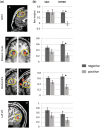Can we share the joy of others? Empathic neural responses to distress vs joy
- PMID: 22156723
- PMCID: PMC3501705
- DOI: 10.1093/scan/nsr073
Can we share the joy of others? Empathic neural responses to distress vs joy
Abstract
The neural bases of empathy have been examined mainly in the context of reacting to others' distress, while almost no attention has been paid to the mechanisms by which we share others' joy. Using functional magnetic resonance imaging, we demonstrated that the same neural network mediates judgment of the emotional state of the other in response to both negative and positive events through empathy-related structures, such as the medial prefrontal cortex (MPFC), the insula, the superior temporal sulcus (STS) and the inferior frontal gyrus (IFG). However, the responses of the MPFC, bilateral insula and the right IFG to negative experiences occurring to the other (but not to the self) were found to be much more intense than the responses to positive experiences, indicating that humans have a remarkable ability to share the distress of others, but may react less to the joy of others.
Figures


References
-
- Amodio DM, Frith CD. Meeting of minds: the medial frontal cortex and social cognition. Nature Reviews Neuroscience. 2006;7(4):268–77. - PubMed
-
- Batson CD, Batson JG, Slingsby JK, Harrell KL, Peekna HM, Todd RM. Empathic joy and the empathy-altruism hypothesis. Journal of Personality and Social Psychology. 1991;61(3):413–26. - PubMed
-
- Blair RJ. Dissociable systems for empathy. Novartis Foundation Symposium. 2007;278:134–41. discussion 141–35, 216–121. - PubMed

